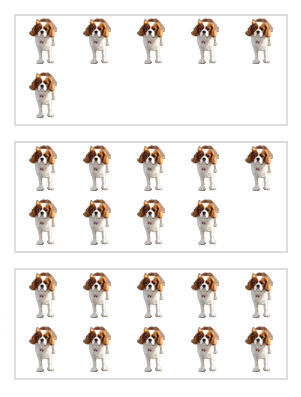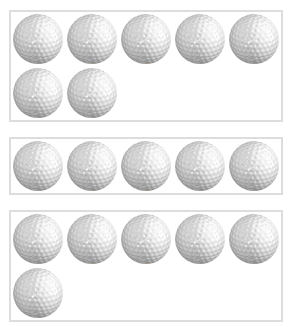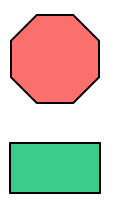How to find out if the child is developing normally.
Tests will help you assess the level of development of the child.
Tests that determine the level of development of a child of 5 years
❀ Dice quiz
Make a blank on paper with the image of what the child should build from the cubes. Ask the child, looking at the drawings, to copy them, that is, to put together from the cubes what he sees on paper.
The test reveals the child's ability to produce spatial differentiation, to combine effectively achieved results with clearly defined goals.
❀ Matryoshka quiz
Invite the child to independently assemble seven nesting dolls into one, focusing on size.
The task is aimed at the ability to correlate the sizes of objects.
❀ Test for sorting objects by shape and color
Prepare multi-colored (red, blue, white) geometric shapes (circles, squares, triangles). These figures can be depicted on cards by painting them in the appropriate color.
Show your child a set of picture cards. geometric shapes. Ask him to sort them into groups by putting a circle, a triangle, a square in front of him. Say, pointing to the corresponding figure: "Put all the circles here, all the triangles here, and all the squares here."
Then mix the cards and, placing the red, blue and white circles in front of the child, in the same way ask him to sort the cards again into new groups - by color. The child does the same with the rest of the figures in turn. And only after the child has completed these tasks, ask him to sort all the figures into groups at once in accordance with their shape and color.
❀ Test for elementary understanding of quantitative relations
Prepare two sets of cards, where the first set shows one item each, and the second set has several (two, three or more). Ask the child to show you a card that shows only one ball, and a card that has a lot of balls, pencils, etc. Let him name the number of objects depicted.
❀ Test for the assimilation of the functional meanings of the subject
Prepare cards with pictures of various objects. Lay out all the cards on the table. Ask your child to show you items that you describe in terms of how you eat them (for example, “Show me what you eat your soup with”).
The child must correctly identify all objects by their functions.
❀ Item grouping test
Cards with the image of animals, people, clothes, transport, food, utensils, furniture are needed (each category is represented by three cards). Ask the child: "Show me pictures of what we eat."
The test shows the degree of development of the child's ability to generalize on a specific functional basis.
❀ General Awareness Test
Ask your child what to do when you want to sleep, eat when it's cold. The child must consistently state all the actions.
❀ Orientation test
Ask the child to lay out the objects in front of him in the same way as they lie in front of you: the car is on the right, the book is on the left. Then ask them to hide the book under the table and get the pencil from under the chair. Ask which is up, which is down, which means go forward, go back, what is in the box and under the box.
❀ Attention test
Take 32 pictures with various objects drawn on them. Have your child look at them carefully. You have in your hands the second exactly the same set of pictures. You show the child one picture and ask him to find a similar one.
❀ Memory test
First explain to the child that he must listen carefully and remember all the actions.
a) Ask to perform several actions in a row: get up from a chair, go around the table, take a book, go with it to the door, knock on the door with your hand, open it and return to your place.
b) Ask the child to remember and repeat the following phrases: “Katya has gone home. Grandma is waiting for her”; “Autumn has come, the leaves are falling”; “The car turned the corner, no one else saw it”; " New Year came, the children received gifts.
c) Then read the number row: 2-6-1; 3-8-6; 2-5-9; 3-4-1-7; 6-1-5-8; 7-2-1-9-6. Ask the child to repeat the spoken numbers.
d) Show the child 10 cards depicting simple and familiar objects. As you show your child the cards one at a time, ask them to name them. (Show one picture at a time, covering all the others.) Then close all the pictures with a sheet of paper, let the child name the pictures that he remembered.
❀ Vocabulary test
Show the child individually pictures of various common, well-known objects and ask: “What is this?” or “What is drawn here?”
❀ Gross motor test
A five-year-old child, going down the stairs, puts one foot on each step.
❀ Fine motor test
A five-year-old child can draw a person, an animal in detail. Depict the eyes, nose, mouth, ears, fingers, details of clothing, wool and claws of the animal.
❀ Test observation "Culture of communication"
A five-year-old child in the process of communicating with peers and adults should be able to thank for the assistance provided, express a request in words, address a peer, calling him by name, speak in a friendly manner, follow the rules of behavior: behave calmly, do not shout, do not interfere with others, do not interfere in the conversation of elders, do not interrupt the speaker.
Your baby is 5 years old, which means that there is a great opportunity to help the baby develop his intelligence in a timely manner. The time has come to check whether the degree of formation of his mental processes corresponds to the norm, to check the potential possibilities in different areas knowledge, to identify in which of them he succeeds, and which require additional attention.
Unfortunately, most adults underestimate the possibilities of this particular age, the needs of children in new information, believe that there is still a lot of time ahead and it is too early to deal with the child. Active preparation for learning begins only a year before entering school. As a result, development stops, the child’s cognitive activity fades, and subsequent express classes lead to overload and overwork, which subsequently cause a negative attitude towards learning.
With the help of these tests, you can easily determine the level of development of your baby, and most importantly, you can summarize the work done on the development of your child, and prepare him for the next, more in-depth stage of training.
By age 5, a child should be able to:
Attention.
Complete tasks without distraction for about 15 minutes.
Find 5-6 differences between objects and between two drawings.
Keep 8-10 objects in sight.
Copy exactly the pattern or movement.
It is easy to play games for attentiveness and speed of reaction. For example, name nouns, but agree before the game: if you hear the name of a toy, clap your hands; if you hear the name school supplies- put your hands on the table; if he heard the name of an object for sports, he put his hands on his shoulders, etc. Or like this: if you hear a word that ends with the sound “a”, raise your hand, etc.
Mathematics.
Numbers 0, 1.2, 3, 4, 5, 6, 7, 8, 9; signs "+", "-", "=",
How to compose and solve problems in one step for addition and subtraction.
How to use arithmetic signs of actions.
How to divide a circle, a square into two and four equal parts.
The composition of the numbers of the first ten.
Direct and reverse order of the number series.
How to get each number of the first ten by adding one to the previous one and subtracting one from the next one in the row.
The name of the current month, the sequence of days of the week.
Memory.
Memorize 8-10 pictures.
Memorize counting rhymes (for example: “Three geese are flying above us, three geese are above the clouds, two have gone down the stream. How many geese were there?”) And tongue twisters (for example: “Chicken and chicken are drinking tea on the street”).
Memorize phrases (for example: “Julia and Olya draw with colored pencils”; “It often rains in autumn”; “Lena played with a ball, cubes, spinning top, doll and bear”).
Tell stories, fairy tales, poems, the content of pictures from memory.
Repeat exactly the text, consisting of 3-4 sentences.
Finish the sentence: “If the table is higher than the chair, then the chair ...”, “If two are more than one, then one ...”, “If the river is deeper than the stream, then the stream ...”, etc.
Find an extra word among a group of words, for example: “Vasily, Fedor, Semyon, Ivanov, Evgeny”, “Nest, hole, anthill, chicken coop, lair”, “Brave, brave, courageous, evil, decisive”.
Answer intricate questions, for example: “When a goose stands on one leg, it weighs 2 kilograms. How much will a goose weigh if it stands on two legs? - etc.
Determine the sequence of events.
Thinking.
Find and explain inconsistencies in drawings.
Find and explain the differences between objects and phenomena.
Find among the proposed items superfluous, explain your choice.
Fold any shape from the constructor according to the model.
Fold out of paper, according to the pattern shown by an adult, a simple object (a boat, a boat, etc.).
Cut out a complex shape with scissors along the outline drawn on a piece of paper.
Perform applications on paper, both independently and according to the model.
Putting together puzzles without assistance.
Fine motor skills.
Adjust the force of pressure on the pencil and brush and change the direction of movement of the hand depending on the shape of the depicted object.
Position the image on the entire sheet or within specified limits: on one line, on a wide strip.
Hatching drawings without going beyond their contours. Carefully color intricate drawings.
Navigate in notebooks in a cage or in a ruler.
The development of speech.
Build complex sentences different types. For example, make sentences from the suggested words: drawing, girl, draw, paint; guys, slide, sled, ride, with, on, etc.
Form new phrases quickly. For example: fur hat | fur hat, etc.
Compose stories from one picture, from a series of pictures, from life.
Perform verses expressively, convey lines containing joy, admiration, sadness, etc., with different intonations.
Make sentences of 3-4 words. Drafting a proposal. Divide simple sentences into words. Divide words into syllables (parts).
Distinguish between vowels and consonants.
Determine which syllable is stressed.
Determine by ear the softness and hardness of sound in words.
Determine the number of sounds and letters in a word.
Determine by intonation which sentence: declarative, exclamatory, interrogative.
The world.
State your first and last name. Name your parents first and last name. Know the name of your city (village). Know the name of the capital of the Motherland. Know the name of our planet.
Know the names of the main professions of people. Explain what characterizes these professions, what benefits people bring.
Name the seasons, parts of the day, days of the week in their sequence.
Name the spring, summer, autumn and winter months.
Distinguish between carnivores and herbivores.
Distinguish migratory birds from wintering ones. Migratory birds
Distinguish garden flowers from field flowers.
Distinguish trees from shrubs.
Name all natural phenomena.
Material taken: http://kinderlove.ru/archives/937
Developmental tests for children 5-6 years old.
Download and print
Additional materials on the topic
Dear users, do not forget to leave your feedback and suggestions!
Developing and educational games in the online store "Integral"
Educational games for children 5-6 years old Educational games for children from 5 years old
A five year old child must:
1. Know the number series from 1 to 10, preferably up to 20.2. Solve the simplest problems for +1 and -1.
3. Be able to navigate on a plane and in space: top - bottom, right - left, forward - back.
4. Know mathematical symbols: +, -, =. Know how to arrange them correctly.
5. Correctly determine the primary colors and their shades: light, dark. Use them when drawing.
6. Know the name of the days of the week and the name of the current month.
Test for counting up to 10
How many rectangles are in the picture? What color are they?
How many stars are in the picture? What color are they?
Count the dogs in each rectangle. 
Count the balls in each rectangle. 
Problem Solving Test
1) Masha has 4 toys in the box. One ball and dolls. How many dolls does Masha have?2) Kolya has two cars and one robot. How many toys does Kolya have?
3) Grandma has four ducklings and one chicken. How many pets does grandma have?
Geometric Shape Recognition Test

Show a square in the picture. What colour is he? 
Show a circle in the picture. What colour is he? 
Show the picture of the cylinder. What colour is he?
Which shape has more angles? Name the colors of the figures. 
Orientation test (inside, outside).
Where is the peach, inside the box or outside the box?
Where is the pepper, inside the box or outside the box? 
What is to the left, a roller or
